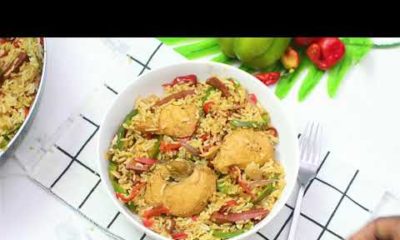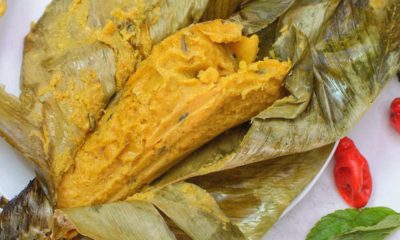Career
Mrs Kush’s Food Business: How to Write a Catering Contract Proposal
 There might come a time in your catering career when someone asks you to provide catering services on a contractual basis and request you send in a proposal. It is also possible that you are looking to spread your wings and get more corporate clients, so that you have a regular stream of income. Whatever your reason, your proposal can be a huge factor in determining whether you get a call back or not. I have assumed that you have the capacity to deliver on what you are proposing, so I wouldn’t dwell much on that. However, for the sake of clarity: only submit a proposal for services you know you can execute.
There might come a time in your catering career when someone asks you to provide catering services on a contractual basis and request you send in a proposal. It is also possible that you are looking to spread your wings and get more corporate clients, so that you have a regular stream of income. Whatever your reason, your proposal can be a huge factor in determining whether you get a call back or not. I have assumed that you have the capacity to deliver on what you are proposing, so I wouldn’t dwell much on that. However, for the sake of clarity: only submit a proposal for services you know you can execute.
Here are some tips on how to go about this:
Research the company
One-size-fits-all does not cut it. You need to know specific details about the company to tailor your proposal to meet their needs. Do they conduct regular meetings and training events? Do they have an existing staff canteen? What sort of kitchen facility do they have? Even if you are only proposing catering for their corporate events, you still need to know these things. An in-house canteen provider will often be the first point of call for such events, before seeking external vendors. If they do have an existing in-house provider it may not be the end. What value can you provide that will make them want to engage your services?
Don’t go and spoil someone’s business because you want contract o! There is always room for added value. If the in-house caterer does mainly Nigerian, you can propose to complement with continental and vice versa. If they do both, you can offer canapés, snacks and nibbles – or even drinks and cocktails. I can tell you that a lot of professional caterers would appreciate the help of sorting out drinks, or wouldn’t mind giving out canapés and nibbles to another provider… so that they can focus on providing quality lip smacking meals.
Clearly state your value proposition
What do you have to bring to the table? You must state this in clear terms – in one paragraph or less. Feel free to expatiate further in the remainder of the proposal or in a follow up meeting. Something along the lines of “We can produce good quality meals at affordable rates, because we buy in bulk from farmers and local manufacturers” is music to the ears of the organisation. Who doesn’t want value for money?
Avoid culinary jargon
This is an area for debate, but you need to massage the ego of the proposal reader. You don’t want them to read your proposal and feel stupid because they couldn’t understand half. Saying things like “Acidulated dressing drizzled over Chicken Alforno” is a no-no. You are not in a Culinary School Olympics. “Spicy Roast Chicken drizzled with lemon vinaigrette” is not only easier to understand but will actually get the readers mouth-watering. Save all the grammar for when you are with your learned colleagues. If you however know for a fact that the person reading your proposal will be a kitchen manager or a Chef, you might want to throw in a bit of culinary terminology in there to show you are knowledgeable. Just be sensible about it.
Nigerian Food is Bae
I learnt this the hard way. In the early days, I made Pretzels, Lasagne et al. I still do on request but I have discovered that the average Nigerian will pick Banga soup and Eba before they pick Shepherd’s pie. When submitting your proposal make sure you reflect this. Never leave out Nigerian food when submitting a proposal to a Nigerian company. Even if it is a multinational make sure you have a good balance. They are in Nigeria for a reason.
Include a sample menu
To paint a picture of the “enjoyment” you aim to provide, give them a sample of your mouth watering menu with very good descriptions.
e.g
Fried Rice, Plantain & Chicken: Nigerian fried rice with chopped carrots, sweet corn, green beans and shrimps served with ripened fried plantain and succulent roasted peppered chicken!
(Don’t you feel like having a plate of fried rice and chicken after reading that description)
Include Pricing
This is not Instagram where you put “DM for price” on product images (Why do people still do that?). Some of these corporate people don’t have time. I can tell you for free that sometimes they jump to the pricing page first before reading the rest of your proposal. In a situation where they have lots of proposals, if the pricing is omitted or not right, the proposal ends up in the bin.
Do your maths well and charge accordingly. Make sure there is healthy margin so that you have room to negotiate downwards. This is Nigeria, everyone likes to bargain – even large petroleum companies. When estimating, make sure you calculate based on the “worst case scenario” e.g there is tomato scarcity, frozen chicken has been banned, plantain is out of season, there is only plastic rice in the market e.t.c. That way you are sure your costs will be adequately covered come rain or shine. It is very unprofessional to increase prices several times in a short period of time. When prices go up, your business should be able to absorb some of those extra costs without having to raise prices often. I may write an article of Maths for Food Business if I get enough interest. Let me know if you’d find that useful.
Make your proposal pretty
This sounds like vanity but I promise you it is not. A lot of humans are visual. Simple things like formatting, font size and even the quality of your paper all play a role in the overall look and feel. You want your proposal to look like it came out of a posh office in Banana Island even if your kitchen is somewhere in Mushin. A well-structured and laid out proposal exudes professionalism and can be a huge advantage for you especially if there are several other proposals you are competing with. It’s helpful to be visually appealing and stand out positively in this regard.
Include pictures
Including pictures is key in my opinion. They may have never experienced your food prior to reading your proposal, so you need to paint a picture… literally. Make sure the pictures are clean and clear and most importantly make sure they are yours. You do not want to risk looking like a fraud when it is discovered that the pictures used in your proposal belong to Mrs Kush ?. Even if you can make the dish perfectly, don’t borrow pictures, it is better to leave it out – if you absolutely cannot use your own. However, taking pictures doesn’t have to be stressful. Most modern camera phones will take decent shots without the need to do any fancy editing.
Be prepared to give free samples
Chances are the person reading your proposal is a human being, and I know for a fact that human beings, especially Nigerian humans, like free food. If your food is delicious and you are sure of it, take along a sample or two when you are invited for a meeting to give you an edge (I call it legal bribery!). Avoid things that have pungent smells like soups with Iru/Ogiri or Fufu et al. Rice dishes and snacks are safer options, most people will eat them without issues. Always ask about food allergies, before giving out your samples and make sure the recipient has indicated they have no known food allergy in the presence of a third party. Wisdom is profitable to direct! I can’t shout!
Give details of your track record
Organizations want people that are experienced but rarely provide the opportunity to gain said experience. If you have an established portfolio, please include brief details that you can expand on in a meeting. If you don’t, don’t lie. You can, however, be a little creative/ generous with your descriptions. Remember when your neighbour asked you to make Jollof Rice and Chicken for his wife’s birthday? Is he not the CEO of Ali & Sons? Yes? Write it!
Maybe your friend’s cousin that ordered 50 packs of small chops for her colleagues on her birthday. You can write something like:
“Supply of finger foods to members of staff at BellaNaija Online Media (private arrangement)”. All join! It is not a lie. The private arrangement in the bracket ensures your statement is not mistaken to mean you were directly contracted by the organization without dwelling too much on the fact.
If after all that is said and done you don’t get the contract, don’t worry sometimes in life we have to knock on a few doors before one opens. Take the experience as a learning opportunity. The next time you write a proposal, you’d see that you’ll do it a lot faster. The process wouldn’t have gone to waste, because you would have gained some knowledge and in this day and age, knowledge is power.
Love,
Mrs Kush
Ps.
The points I highlighted are some of the things I have used in the past when writing proposals. Sometimes I got the contract and sometimes I didn’t. I am sure there are lots of ways to improve on these tips, please feel free to share in the comments. If you would like a sample of an actual proposal I wrote that won the contract, (after a series of follow up meetings and negotiations) click here. Some of the details have been omitted for obvious reasons! It, however, contains at least 80% of the document. I have used BellaNaija as the sample client.
Photo Credit: Innovatedcaptures | Dreamstime.com





















